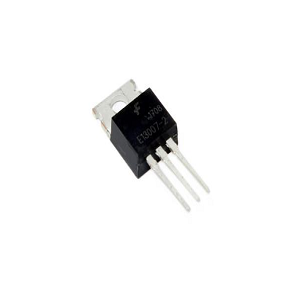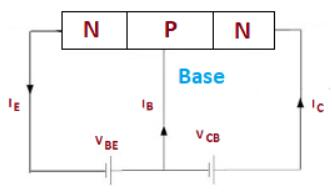MJE13007 Transistor: Pinout, Features, and Datasheet
The MJE13007 is an NPN bipolar power transistor, specifically crafted for high-voltage, fast-switching power circuits. This article delves into the MJE13007, shedding light on its unique attributes, diverse applications, technical specifications, and similar components. Through this exploration, we aim to uncover the nuances that make the MJE13007 a standout choice in its field.Catalog

Overview of MJE13007
Meticulously designed for dynamic high-speed and high-voltage switching tasks, the MJE13007 traverses effortlessly between 115V and 220V systems. This makes it a preferred choice in a multitude of devices such as switching regulators, inverters, and motor controls. Possessing substantial voltage specifications, 400V VCEO and 700V VCBO, it is adept at managing inductive load circuits, showcasing a remarkable reverse bias capability. These characteristics play a role in optimizing performance in different applications. The MJE13007's flexibility in handling varied voltage systems grants it an edge in enhancing the efficiency of electronic applications. Its seamless operation across different voltage environments makes it highly applicable in eclectic technical domains, reflecting reliability and effectiveness that resonate with your expectations in practical scenarios.
Standing out with its 400V VCEO and robust 700V VCBO, the MJE13007 reliably meets rigorous high-voltage demands. These features, appreciated by others, bolster effective management of electrical currents, minimizing disruptions and failures. The insights garnered through its application underscore its resilience under substantial electrical stress, strengthening system endurance over time. When faced with the intricacies of managing inductive load circuits, the design of the MJE13007 excels. The transistor's powerful reverse bias capacity aids its adaptability in these challenging applications, mitigating risks and extending service life. Its seamless integration into circuits managing alternating current attests to the efficacy of its design.
Equivalent and Replacement for MJE13007
MJE13005, MJE13006, MJE15020, FJP13007, KSE13006, KSE13007, KSE13007F, MJE13007A, MJE13007G, STD13007F, BUJ105A, BUJ105AX, PHE13007, ST13007, BUL138, BUL128D-B, BUL381D, 2SC2898, MJE13006, 2SC233, 2SC427, 2SC2335, 2SC2553, TE13007
MJE13007 Pin Configuration

MJE13007 Footprint and CAD Model


MJE13007 Specifications
|
Type |
Parameter |
|
Lifecycle Status |
LAST SHIPMENTS (Last Updated: 1 day ago) |
|
Package / Case |
TO-220-3 |
|
Number of Pins |
3 |
|
Collector-Emitter Breakdown Voltage |
400V |
|
hFEMin |
8 |
|
Packaging |
Tube |
|
Published |
2009 |
|
Pbfree Code |
no |
|
Moisture Sensitivity Level (MSL) |
1 (Unlimited) |
|
ECCN Code |
EAR99 |
|
Voltage - Rated DC |
400V |
|
Peak Reflow Temperature (Cel) |
240 |
|
Current Rating |
8A |
|
Pin Count |
3 |
|
Mounting Type |
Through Hole |
|
Surface Mount |
NO |
|
Transistor Element Material |
SILICON |
|
Number of Elements |
1 |
|
Operating Temperature |
-65°C -150°C |
|
Series |
SWITCHMODE™ |
|
JESD-609 Code |
e0 |
|
Part Status |
Obsolete |
|
Number of Terminations |
3 |
|
Terminal Finish |
Tin/Lead (Sn/Pb) |
|
Max Power Dissipation |
80W |
|
Reach Compliance Code |
not_compliant |
|
Time@Peak Reflow Temperature-Max (s) |
30 |
|
Qualification Status |
Not Qualified |
|
Element Configuration |
Single |
|
Gain Bandwidth Product |
14MHz |
|
Transistor Type |
NPN |
|
Max Collector Current |
8A |
|
Current - Collector Cutoff (Max) |
100μA |
|
Vce Saturation (Max) @ Ib, Ic |
3V @ 2A, 8A |
|
Collector Base Voltage (VCBO) |
700V |
|
RoHS Status |
Non-RoHS Compliant |
|
Power Dissipation |
80W |
|
Polarity/Channel Type |
NPN |
|
Collector Emitter Voltage (VCEO) |
3V |
|
DC Current Gain (hFE) (Min) @ Ic, Vce |
5 @ 5A 5V |
|
JEDEC-95 Code |
TO-220AB |
|
Transition Frequency |
14MHz |
|
Emitter Base Voltage (VEBO) |
9V |
|
Lead Free |
Contains Lead |
|
Case Connection |
COLLECTOR |
|
Transistor Application |
SWITCHING |
MJE13007 Features
The MJE13007, an NPN transistor, adeptly navigates high-voltage environments, particularly within collector-emitter and collector-base circuits. Its durable design accommodates a power dissipation capacity of up to 80 watts. Such capabilities make it well-suited for high-power tasks where dependability is valued. In practical use, incorporating effective heat dissipation techniques, like heat sinks, plays a role in preserving thermal balance and functionality.
Encased in the adaptable TO-220 package, noted for both thermal efficiency and ease of assembly, this transistor is frequently used in power supply circuits and motor controls, handling power demands. Application reveal that leveraging the MJE13007 efficiently involves aligning its power-handling strengths with strategies for thermal regulation. Approaches may include active or passive cooling to avert issues from overheating.
Applications of MJE13007
Power Supply Systems
Within uninterrupted power supplies (UPS), MJE13007 operates as a reliable guardian during outages, skillfully managing voltage and current variations. The transistor supports efficient DC to AC conversion, ensuring energy is preserved with impressive efficiency. Optimizing its configuration can noticeably boost UPS performance in maintaining balance among connected devices.
High-Voltage Switching Operations
MJE13007 proves excellent in high-voltage switching applications. Its capacity to manage high voltages ensures safe and effective switch functions, providing with confidence in its consistent performance in industrial settings. Incorporating MJE13007 stabilizes operations under varied load conditions, enhancing overall system reliability.
Inverter Circuit Design
Chosen frequently for inverter circuits, MJE13007’s adept switching abilities facilitate DC to AC conversions for renewable energy systems, like solar inverters. Its rapid switching capability smoothens energy transitions, lowering losses and enhancing output. Thoughtful design consideration of MJE13007 elevates system efficiency and stability.
Motor Control Applications
In motor control systems, MJE13007 supports strong torque and speed management, thanks to its high current capacity and swift switching. It effectively controls various motor types, improving operational efficiency. Utilizing MJE13007 enables precise motor modulation for industrial automation and electronics.
Power Supply Modules
MJE13007 excels in power supply modules, offering notable thermal performance and signal amplification efficiency. Integrating this transistor enhances system reliability while managing high loads, advantageous for consistent power delivery in environments like data centers or telecommunication infrastructures.
Audio Amplification
In audio amplifiers, MJE13007 aids in both signal switching and amplification, ensuring clarity and strength in high-fidelity systems. It maintains signal integrity across different frequencies, delivering richer sound quality. The MJE13007 transistor stands out in diverse applications, providing steady performance, efficient power management, and adaptability to various electronic requirements, underlining its lasting in modern electronics.
Effective Usage of MJE13007
Incorporating the MJE13007 transistor into your projects involves careful attention to its specifications to ensure it lasts. Functioning within 80% of its rated capabilities fosters reliability and longevity. It's prudent to set the current limit at 5.12A and keep the voltage across the collector-emitter junction capped at 256V. These considerations play a role in mitigating stress and possible damage.
Due to the considerable heat produced during operation, proper heat management becomes needed. Using heatsinks, or even fans at higher power levels, can assist in maintaining the device's temperature within acceptable ranges. These cooling solutions help protect the device's functionality. Thoughtful thermal design not only boosts performance but also helps avoid overheating issues.
Circuit Design Using the MJE13007

Navigating Thermal and Electrical Constraints
When crafting a circuit with the MJE13007 transistor, attentiveness to its thermal and electrical boundaries is required for both stability and lasting performance. The operating temperature range should remain within -65°C to 150°C. Observing these parameters not only enhances performance but also guards against premature breakdown due to thermal stress. You might utilize thermal management methods like heat sinks or cooling systems, leveraging industry practices for effective heat dissipation in electronic components.
Techniques for Thermal Management
Efficient heat management plays a role in circuits incorporating the MJE13007. Using heat sinks effectively dissipates excess heat, sustaining the transistor's functionality. Layout optimization to improve airflow can further aid in temperature regulation. Employing thermal pads or conductive materials facilitates heat transfer from the device. Practical strategies include assessing environmental variables and designing the circuit layout to allow natural heat escape, enhancing operational consistency.
Electrical Factors and Expertise
Electrical considerations are just as impactful as thermal aspects. Designing circuits with suitable voltage and current levels mitigates electrical strain. Others frequently integrate protective components like diodes or fuses to counteract overcurrent issues. Practical insights reveal that managing voltage spikes with snubber circuits or clamping diodes boosts component reliability.
From hands-on applications, a comprehensive strategy that integrates both electrical and thermal management provides superior outcomes. Balancing these facets can inspire innovative circuit designs that fully leverage the capabilities of the MJE13007.
Dimensions of MJE13007

MJE13007 Manufacturer Information
ON Semiconductor stands at the forefront of producing the MJE13007, esteemed for its reliable and innovative semiconductor advancements. Their deep knowledge in energy management signifies a commitment to embracing sustainability and pushing technological boundaries across diverse fields. ON Semiconductor, always looking forward, invests substantially in research and development. Their priorities include creating solutions that excel in efficiency and are environmentally sound. This aligns with worldwide trends favoring sustainable growth.
Datasheet PDF
MJE13007 Datasheets:
Multiple Devices 30/Jun/2006.pdf
Frequently Asked Questions [FAQ]
1. How does MJE13007 shine in its applications?
The MJE13007 transistor thrives in high-voltage, rapid power-switching circuits. Its design makes it a go-to choice for applications like switching regulators and inverters. Many often find its rugged build a reliable ally when performance is sought in challenging environments.
2. What is the operational role of MJE13007?
As an NPN bipolar transistor with a silicon substrate, the MJE13007 efficiently manages electronic signals. It handles voltages and currents, dissipating up to 80 watts during active phases. Its ability to remain stable across varying electrical conditions is highly valued in advanced power systems, where such resilience is often admired.
3. Can MJE13007 and MJE13007-2 be used interchangeably?
Yes, the MJE13007 and MJE13007-2 are interchangeable in circuit designs. Although the MJE13007-2 might feature a slightly larger chip, their functions align perfectly. Others appreciate the flexibility of these components provide, enabling seamless integration into various projects without losing functionality.